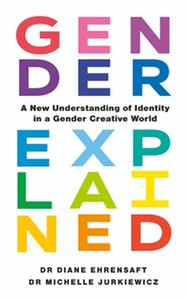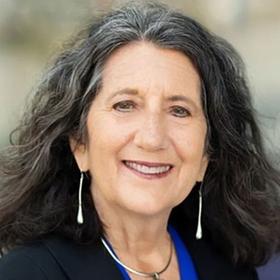
Diane Ehrensaft is a developmental and clinical psychologist, and author of The Gender Creative Child and Gender Born, Gender Made. At the University of California, San Francisco, she is the cofounder and director of mental health at the Child and Adolescent Gender Center and an associate professor of pediatrics. She has been featured in the Los Angeles Times online and Wired online and has appeared on Anderson Live, The Oprah Winfrey Show, and TheToday Show.
Michelle Jurkiewicz is a clinical psychologist and gender specialist in Berkeley, Calif., providing therapeutic services to children, youth, and families since 2003. Jurkiewicz was an early pioneer in working with transgender, nonbinary, and gender expansive youth. In addition to providing psychotherapy for people of all ages, she trains newer clinicians in using the gender affirmative model.
Ehrensaft and Jurkiewicz teamed up for Gender Explained: A New Understanding of Identity in a Gender Creative World (The Experiment; reviewed in this issue), an introduction to the concepts of gender creativity and gender-affirming care.
How did you approach co-writing this book, especially as authors from two different generations?
Michelle Jurkiewicz: We each took the lead on five chapters, and we had input into the other chapters too. We've had different experiences with gender and watching the gender affirmative model develop and grow, though Diane brings in more about her generation.
Diane Ehrensaft: Our childhoods were very different. I was born in 1946, when girls had to wear skirts to school in Chicago, no matter what the weather. And Michelle didn't have to deal with that. But more than differences, we have beautifully discovered similarities. We've worked together for a long time, so the perspective was not a surprise. We both identify as cisgender women, but for both of us, there's no way we take shit from anybody around sexism and women not having a voice.
Jurkiewicz: It was clear that even though we were born in different generations, we both see the progression throughout the last 100 years or so as contributing to where we are today.

|
|
| Diane Ehrensaft | |
The intended audience for this book is adults, but you seem aware that gender-diverse kids and teens might read it, too. How did you think about those two audiences?
Ehrensaft: An eight-year-old once came into my office holding my previous book, The Gender Creative Child, saying, "I'm reading it with my mommies!" So I always assume that kids might have their parents share this sort of book with them, or they might pick it up on their own.
Jurkiewicz: We're speaking about children's and teens' experiences and trying to include their voices as much as possible. They were always at the forefront of our minds, which is a big part of it.
Even though you are cisgender women, did you experience your own gender exploration?
Ehrensaft: Definitely! I was a late bloomer and geeky teenager who loved math and did ballet. I was completely confused about my gender. I never thought, "I must be a boy." I believed in God at the time, and I came up with the theory that God forgot to give me a uterus, so I was an in-between person.
Then in 2022, a close friend / colleague and I were exploring our gender histories. We asked: "If we were in high school now, would we identify as non-binary?" I've also done the experiment of "If I woke up tomorrow with a penis or with people calling me 'Mr.', how would I feel?" I liked pretending I was a little brother instead of sister when I was a kid. But how would I feel as an adult? It's helped me to do that exercise, and I ask parents to do it, too.
 |
|
| Michelle Jurkiewicz (photo: Ben Krantz) |
|
Jurkiewicz: I grew up in a stereotypically gendered family and region. I was very girly, and I didn't question that until I took my first women's studies class in college. It opened up this whole new way of seeing the world. It also made me start to question how I presented my own gender. At that point, identifying as a woman was important to me, but what it meant to be a woman and how to express being a woman--I was grappling and experimenting with all of that. Then, because of my interest in gender as well as my gender-diverse friends and colleagues, I got more and more excited and professionally involved.
I've also wondered about how I would discover or express my gender differently today than when I was growing up. Working with my clients, I hear about their experiences daily. I try to imagine myself in their shoes, what it's like walking around as a transgender or gender-diverse young person.
Can you say more about this idea of exploration and learning about gender as an ongoing process?
Jurkiewicz: Even if your gender identity doesn't shift, how you interact with the world and how the world interacts with you is affected by gender. And that's always shifting. The way I experienced being a woman in my 20s is very different than in my 40s. And in the work I do with children, I watch their genders unfold and grow and develop. That's a delicate balance we're always holding: affirming a child's gender while also making sure there's space for them to explore if they want or need to.
Ehrensaft: The term "gender exploration" is sometimes read as "press pause and explore, because a child or teen couldn't possibly know now." That's not what we mean. We honor knowability, that a child or teenager can know their gender. They don't have to be asked to explore for five years to prove anything. What we do is a deep dive with the youth and their family to get the young person's gender in focus and develop a plan for them. And absolutely, it can change over time. It has to do with gender evolution for all of us.
You introduce terms like "gender web" and "Rapid Onset Parental Discovery." What do you think is the value of coining new terms?
Ehrensaft: They help us think about things in new gender-creative ways. I loved the notion of gender spectrum because it got away from gender boxes. But it was linear between two points: boy-girl, male-female. We needed something that doesn't keep those, so I made up the web. Others coined similar terms with the same intent. Rapid Onset Parental Discovery was different. I purposely meant it as a counterpoint to the erroneous idea of Rapid Onset Gender Discovery, to be provocative, because that's where the real issue is.
Jurkiewicz: Terms like gender web resonate with families because you can get a feel for it before reading the definition. A lot of adults feel like they don't understand what's going on. Offering more accessible terms invites people in rather than making them feel like outsiders.
Ehrensaft: I also coined "social gender dysphoria." It's not the children experiencing the primary dysphoria. It's the culture, which is then internalized by the children or parents. If we could dispel adults' confusion and treat social gender dysphoria, the kids will have a better go of it.
Jurkiewicz: Yes, there's so much talk about these young people having psychological problems as though they originate inside of them. That is not what we see.
What do you want readers to take away from this book, especially in regard to community responsibility?
Jurkiewicz: Gender diversity is a normal human variation, and the kids are doing something exciting by opening this space up. It's good for all of us because traditional gender roles and stereotypes really limit everybody. And the distress around youths' gender identity isn't because of their gender but how society responds to them. The adults--all of us--are responsible for their distress, which means we can shift that.
Ehrensaft: We hope to reduce anxiety and increase curiosity. We talk about being reflective rather than reactive about your own gender or your children's gender, and what you can do to help the country and the world. Because it isn't about a small group of children. It's about a whole society.
Right now in the United States, gender is weaponized as a political ax with great harm. It's an easy target, given certain values. But these children are ascending. The notion of gender not in two boxes isn't going away. Although the White House's stance about transgender care is still unclear and they haven't taken back their statement about surgeries, the Biden administration put out a statement--based on protests and pushback from major organizations--that they support gender care for minors. So I'm optimistic.
We hope we can move people toward working together, recognizing that we're in a transitional state that makes us all anxious. But there's new bedrock, and it's going to be okay. --Dainy Bernstein, freelance reviewer

